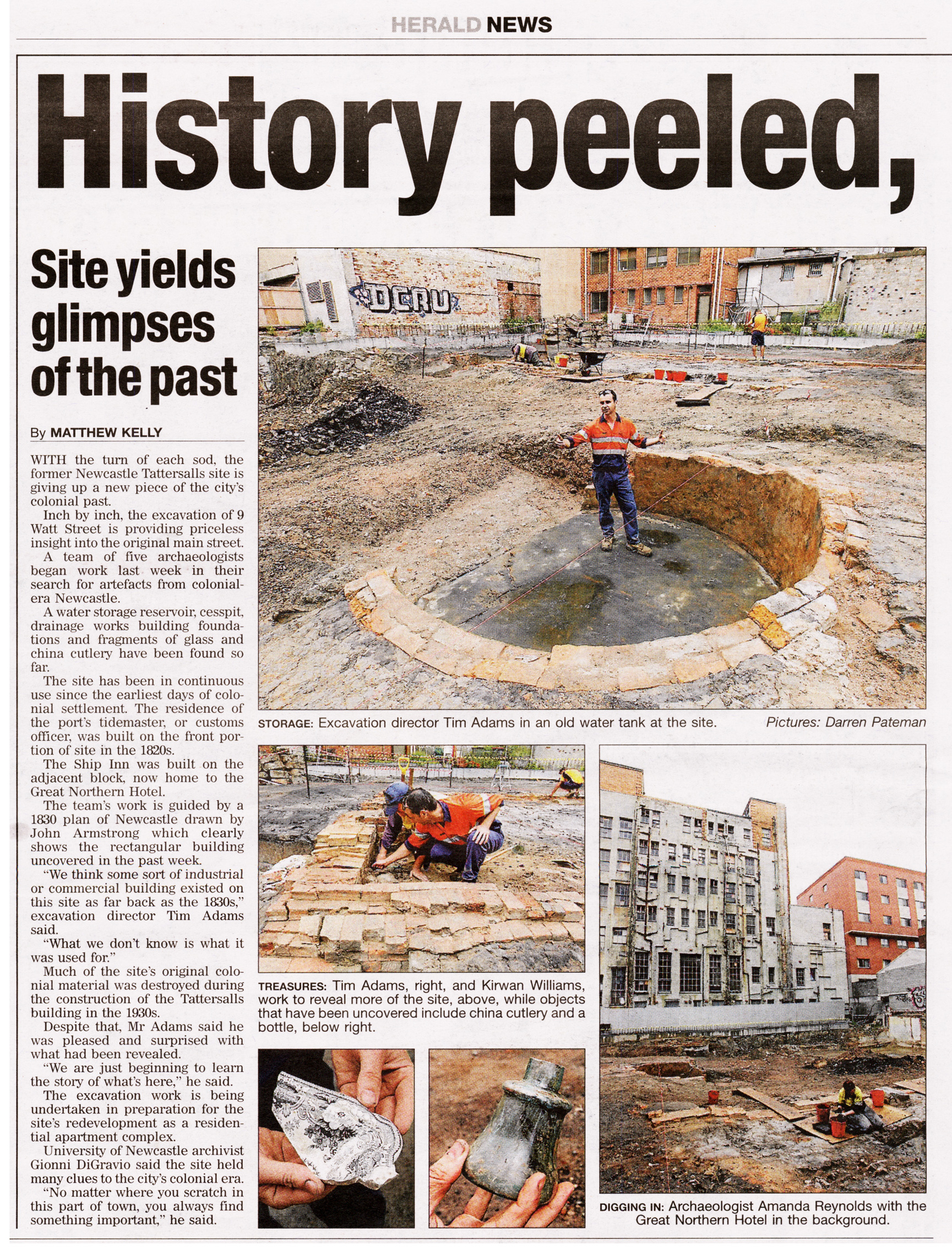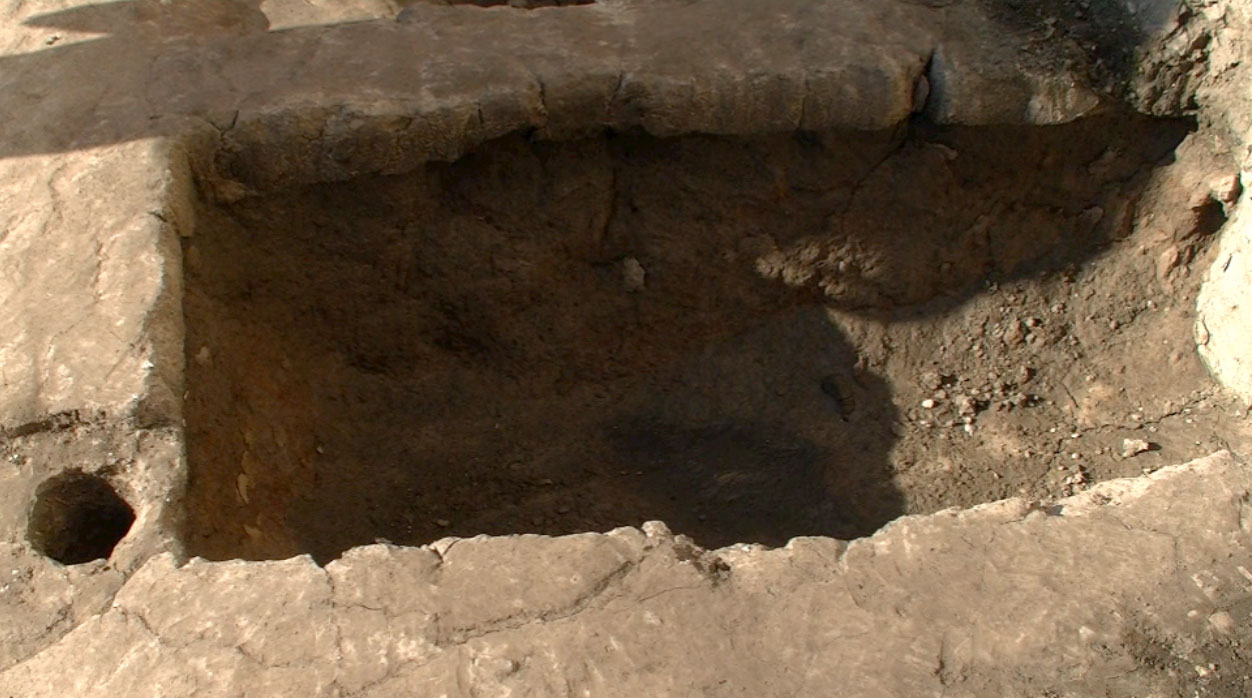On the afternoon of the 2nd April 2014 both Dr Ann Hardy and Gionni Di Gravio of the University of Newcastle (Australia) were invited to visit the archaeological excavations at the former Tattersalls site at 9 Watt Street Newcastle.
Their guide on the tour was Tim Adams, Senior Archaeologist and Excavation Director with Umwelt (Australia) Pty Ltd.
Tide Waiter’s Residence (c.1820s)
The site of 9 Watt Street has been in near continuous use since the inception of Newcastle’s European settlement, with occupation on the site recorded as early as the 1820s with the Tide Waiter’s Residence. The Tide Waiter would have acted much like the town’s customs officer of the time, and inspected ships arriving the harbour, and docking at the wharf once situated at the end of Watt Street (now somewhere under the roundabout near Newcastle Railway Station).
The residence is thought to have comprised a stone house built back from the street frontage. The adjacent block on the corner of Watt and Scott streets has been the location of a hotel since 1823 when the Ship Inn was constructed on the site now occupied by the Great Northern Hotel.


No remains have been discovered of the Tide Waiters Residence, as it is believed that the excavations in the 1930s to construct the Tattersalls Club removed all remains at that level of the site. The only remains discovered were a cesspit and a circular water cistern that was photographed in a article in the Newcastle Herald from the 22nd January 2014 p.2 and also appears in the 1897 Water Board plans.


Alexander Walker Scott’s Newcastle House (1838)

Alexander Walker Scott (an entrepreneur, natural scientist and one of Newcastle prominent business identities) is reported to have constructed ‘a fine mansion’ known as Newcastle House on the site of the Tide Waiter’s Residence in approximately 1838. (Heritas 2003: 4)
In addition Scott purchased land in Stockton where he constructed a salt works, a woollen textile mill and an iron foundry. He also owned Ash Island in the Hunter River estuary near Hexham. He and his family lived in a small cottage on the island following the economic depression of the early 1840s when they had to leave their Watt Street residence. The sandstone foundations of this structure still remain, and were incorporated as part of the new banking premises that were later erected.

Bank of NSW (1853)
Newcastle House was purchase by the Bank of N.S.W. in 1853 with the Bank relocating into the Watt Street building in 1856. In 1870 a ‘new banking premises’ was built on the site which is thought to have incorporated parts of Scott’s original Newcastle House. (Heritas 2003: 5-6)
Tattersall’s Club (1934)
In 1934 the Bank of N.S.W. building was sold to the Newcastle Tattersall’s Club. The Tattersall’s Club had been formed in 1869 by a group of bookmakers who wanted to stage races at the Newcastle Jockey Club when it was not being used for regular race meetings (Heritas 2003: 8)
Rear of 11 Watt Street Newcastle
The more interesting site was to be found around the corner at the rear of 11 Watt Street. It contains an existing rectangular structure, probably a private building, erected in the 1820s and marked on John Armstrong’s 1830 plan.

This building was later the premises of James Clark, Sailmaker, during the 1870s to the 1880s. The trench discovered, along with an intricate series of drainage works needs further investigation and study before we can fully ascertain what is going on there. In the trench was found much saw dust material pointing to its possible use in timber cutting or ship building possibly.



Oddities
A couple of oddities were discovered on the site. Firstly at the rear of the site in a square trench was discovered an up ended baby cow, and closeby, a burial of a small pet with a crucifix(?), the remains were housed in a bottle, and may have been some sort of small creature like a bird. A chemical analysis will eventually tell us what it is.

Reference: Surf City, Newcastle NSW Heritage Impact Assessment. Heritas Architecture. 2003. (1.2 MB PDF)
2 thoughts on “Archaeological Site Visit – 9 Watt Street Newcastle (Tattersalls)”